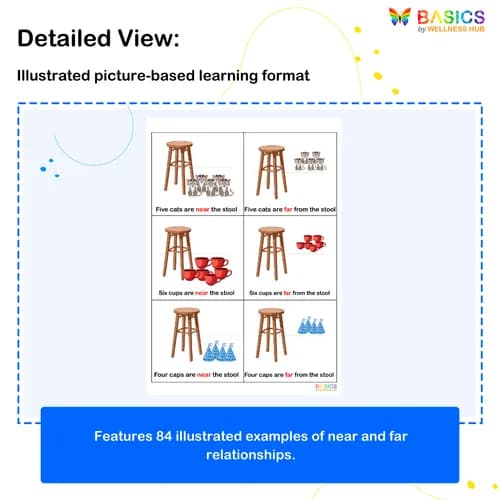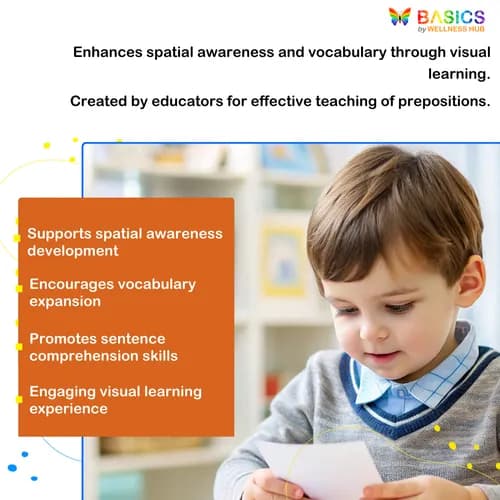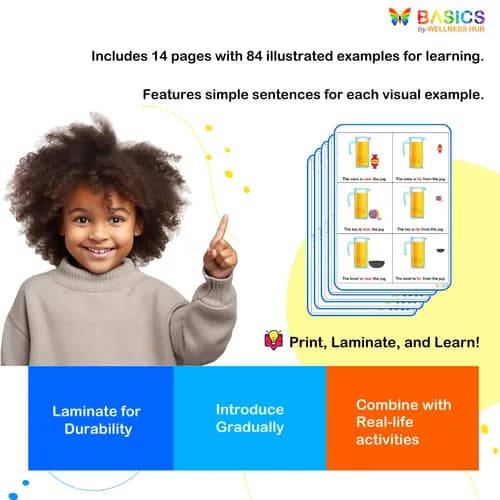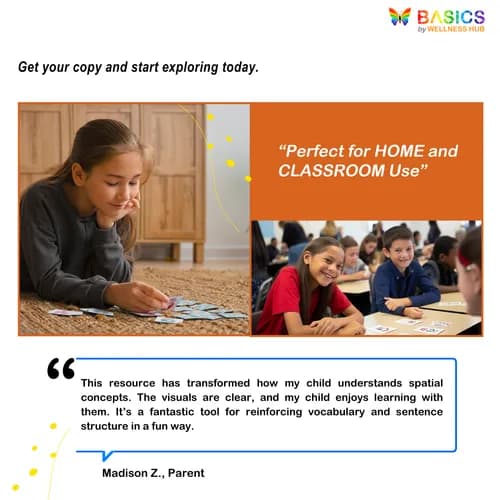





NEAR & FAR – Learn Object Position with Prepositions
₹80
₹160
50% off
0 (0 ratings)
Grade Levels
Pre-K - Grade 2 (Ages 3-7)
Content Overview
Format: Printable PDF | Pages: 14 | Features: 84 illustrated examples of 'near' and 'far' with descriptive sentences.
Categories
Pages from the Resource
Help children grasp the concepts of 'near' and 'far' with this engaging printable PDF. Featuring 84 illustrated examples, each page provides clear visual representations and simple sentences to enhance spatial awareness and vocabulary. Ideal for early learners and those with special needs.
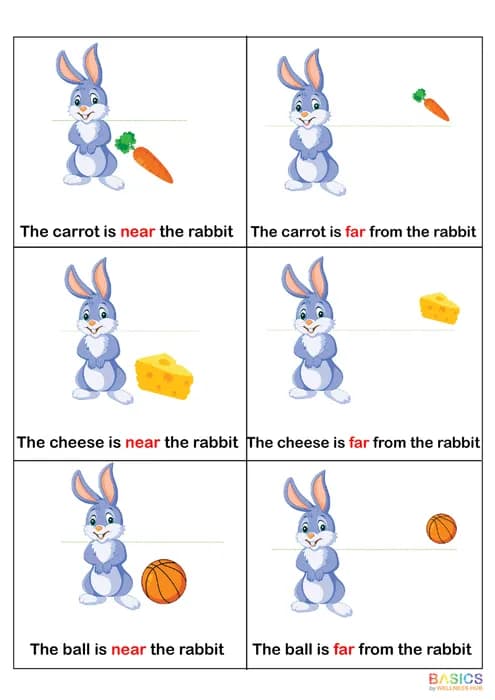
Page 1

Page 2
What Users Say
0
0 ratings
5
0+
4
0+
3
0+
2
0+
1
0+
5 Stars
Product is Good to use.
1 year ago
Varsha Parent
Similar Products
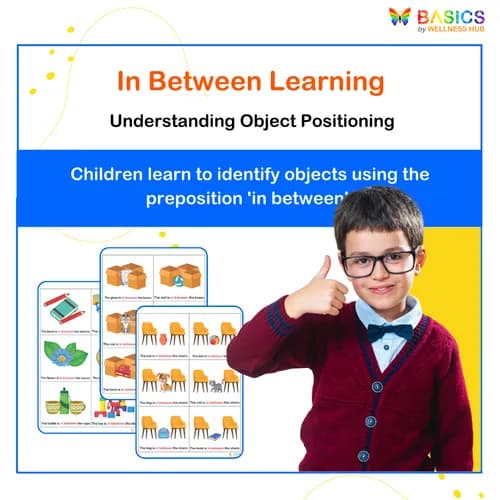
In Between – Learn Object Position with Illustrated Examples
₹ 80.00
₹ 160.00
50% off
4.9 (52 ratings)
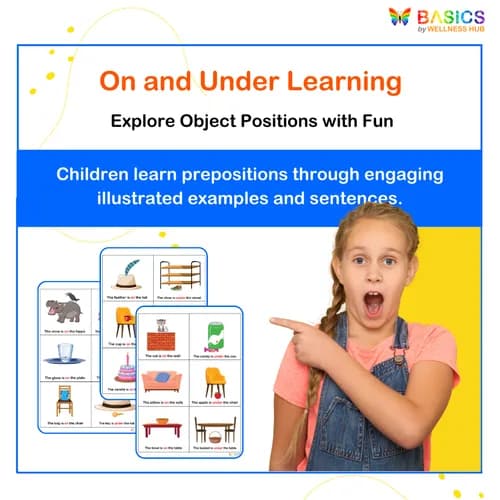
ON & UNDER: Mixed Object Sets – Prepositions Activity for Kids
₹ 80.00
₹ 160.00
50% off
4.9 (52 ratings)
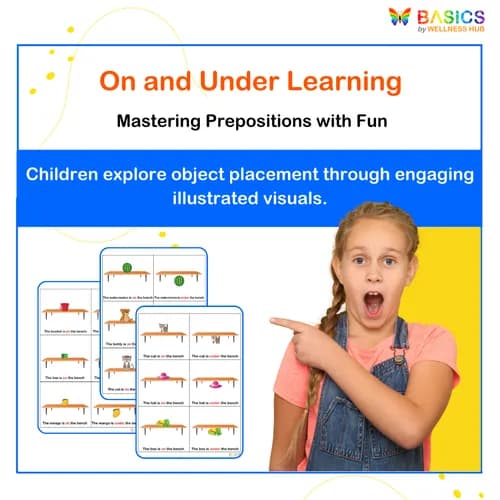
ON & UNDER: Basic Object Position – Printable PDF for Kids
₹ 80.00
₹ 160.00
50% off
4.8 (48 ratings)
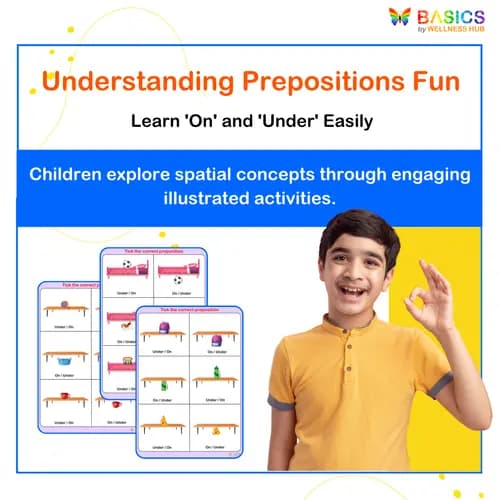
On and Under Prepositions Activity: Printable PDF for Kids
₹ 80.00
₹ 160.00
50% off
4.9 (52 ratings)
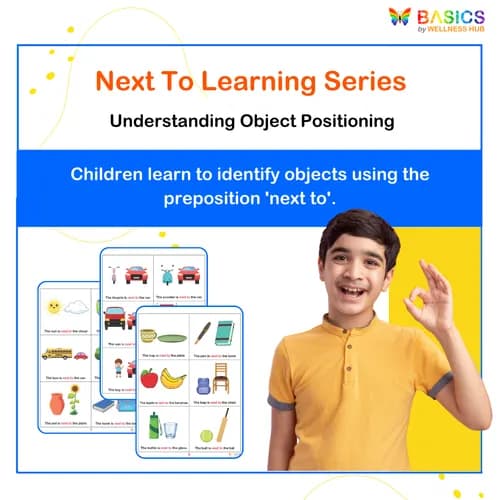
NEXT TO – Learn Object Position with “Next To”
₹ 80.00
₹ 160.00
50% off
4.8 (48 ratings)
About the Product
Introduction
Understanding spatial relationships is a critical skill for young learners, and the NEAR & FAR – Learn Object Position with "Near" and "Far" printable PDF is designed to help children ages 4-8 master these important prepositions. This engaging resource features 14 pages filled with colorful illustrations that depict objects and people in varying distances, making the concepts of "near" and "far" tangible and easy to grasp. Each page includes six pictures—three showing objects positioned near one another and three showing them far apart—accompanied by simple descriptive sentences that reinforce the learning process.
By using this resource, parents, teachers, and therapists can support children's spatial awareness, vocabulary development, and sentence comprehension in a fun and interactive way. The visual examples provide an intuitive approach to understanding distance, making it suitable for use in classrooms, at home, or in therapeutic settings. This resource is perfect for enhancing language skills while promoting cognitive development in young children.
Product Details
- Resource Name: NEAR & FAR – Learn Object Position with "Near" and "Far"
- Format: Printable PDF
- Total Pages: 14
- Illustrated Pictures: 84 total (6 pictures per page)
- Content Breakdown: Each page contains 3 examples of "near" and 3 examples of "far"
- Example Sentences: Simple descriptive sentences accompanying each image (e.g., "The boy is near the tree.")
- Designed For: Early childhood education, speech therapy, and language development
- Best Suited For: Ages 4-8, Pre-K, Kindergarten, and Grade 1
- Usage Notes: Ideal for interactive learning, can be printed and laminated for durability and repeated use.
Educational Benefits
1. Enhances Spatial Awareness
- Helps children understand the concept of distance through visual examples.
- Encourages them to recognize and describe spatial relationships in their environment.
2. Expands Vocabulary
- Introduces and reinforces the prepositions "near" and "far" in a contextual manner.
- Supports language development by providing descriptive sentences that enhance word usage.
3. Improves Sentence Comprehension
- Strengthens understanding of sentence structure through clear, simple examples.
- Encourages children to construct their own sentences using "near" and "far."
4. Engages Visual Learning
- Utilizes colorful illustrations to capture children's attention and make learning enjoyable.
- Supports different learning styles, particularly visual learners, by providing concrete examples.
5. Facilitates Interactive Learning
- Encourages participation and discussion as children identify and describe relationships in the images.
- Promotes collaborative learning opportunities in group settings, such as classrooms or therapy sessions.
Instructions for Use
Step 1: Print the PDF
- Download and print the NEAR & FAR resource on standard A4 or Letter-sized paper.
- Consider laminating the pages for durability and repeated use.
Step 2: Introduce the Concepts
- Begin by explaining the terms "near" and "far" using simple language.
- Show a few examples from the resource and describe the relationships depicted.
Step 3: Engage with the Illustrations
- Go through each page together, asking the child to identify which images show "near" and which show "far."
- Encourage them to read the descriptive sentences aloud to reinforce understanding.
Step 4: Create Interactive Activities
- Use the illustrations to create games, such as:
- Asking the child to point to an object that is "near" another object.
- Having them describe their own surroundings using "near" and "far."
Step 5: Encourage Sentence Creation
- Prompt the child to create their own sentences using "near" and "far" based on the images.
- Ask questions like, "Can you tell me about something that is near your toy?" to reinforce learning.
Step 6: Review and Reinforce
- Revisit the resource regularly to reinforce the concepts.
- Encourage children to use "near" and "far" in their everyday conversations to solidify their understanding.
Step 7: Adapt for Different Learning Levels
- For advanced learners, introduce additional spatial concepts or related vocabulary.
- For younger or struggling learners, focus on fewer examples and provide more guided support.
Activities Using the Resource
1. Picture Sorting Game
Objective: Help children distinguish between "near" and "far" through hands-on sorting.
How to Play:
- Print and cut out the illustrated pictures from the PDF.
- Create two sorting piles labeled "Near" and "Far."
- Have the child sort the pictures into the correct piles while saying the corresponding sentences.
Skill Development:
- Spatial awareness
- Vocabulary reinforcement
- Categorization skills
2. Scavenger Hunt
Objective: Encourage real-world application of "near" and "far" concepts.
How to Play:
- Create a simple scavenger hunt list using items that can be found "near" and "far" in the home or yard.
- Ask the child to find an object that is near a specific item (e.g., "Find something near the couch") and one that is far (e.g., "Find something far from the door").
- Discuss their findings using sentences from the resource.
Skill Development:
- Environmental awareness
- Sentence construction
- Critical thinking
3. Sentence Creation Relay
Objective: Promote sentence formation and verbal expression.
How to Play:
- Divide into two teams and take turns picking a picture from the resource.
- Each team must create a sentence using "near" or "far" based on the chosen picture.
- The team with the most correct sentences wins.
Skill Development:
- Collaborative learning
- Expressive language
- Teamwork
4. Distance Drawing Activity
Objective: Enhance understanding of "near" and "far" through creative expression.
How to Play:
- Provide paper and drawing materials.
- Ask the child to draw a scene that includes objects or people positioned "near" and "far" from each other.
- Have them label their drawings with sentences like, "The cat is near the house" or "The dog is far from the tree."
Skill Development:
- Creativity and imagination
- Spatial reasoning
- Sentence writing
5. Interactive Storytelling
Objective: Foster narrative skills and comprehension through storytelling.
How to Play:
- Read a story that includes the concepts of "near" and "far."
- Pause at key moments to ask the child to describe what is happening using the terms.
- Encourage them to create their own short story using the illustrations from the resource as prompts.
Skill Development:
- Narrative development
- Listening comprehension
- Creative thinking
6. Movement Activity
Objective: Connect physical movement with spatial concepts.
How to Play:
- Set up a designated area with objects placed at various distances.
- Call out commands like, "Stand near the chair" or "Walk far from the table."
- Have the child follow the directions and describe their position using the terms "near" and "far."
Skill Development:
- Physical awareness
- Listening skills
- Vocabulary application
Frequently Asked Questions
Q1: What age group is this resource designed for?
A1: The NEAR & FAR resource is specifically designed for children ages 4-8, making it suitable for preschool through Grade 1. The engaging illustrations and simple sentences help young learners grasp the concepts of "near" and "far" in a fun and interactive way. This age range is critical for developing spatial awareness and vocabulary, and the resource aligns well with early childhood education standards.
Q2: How can I use this resource in a therapy setting?
A2: This resource is excellent for speech and language therapy, as it targets spatial awareness and vocabulary development. Therapists can use the illustrated examples to facilitate discussions, encourage sentence formation, and assess comprehension of prepositions in a structured manner. Additionally, the visual nature of the resource helps children with different learning styles engage more effectively during sessions.
Q3: Can this resource be used in group settings?
A3: Yes, the NEAR & FAR resource can be effectively utilized in group settings such as classrooms or therapy groups. With 14 pages and multiple examples, it allows for collaborative activities where children can work together to identify and describe the positions of objects. This not only promotes social interaction but also reinforces learning through peer discussions and shared experiences.
Q4: What is your refund policy if I am not satisfied with the resource?
A4: At Wellness Hub, we strive to provide high-quality resources. If you are not satisfied with your purchase, please contact our support team within 30 days of your purchase for assistance. We will review your request and may offer a refund or exchange based on the circumstances. Your satisfaction is important to us, and we want to ensure you have a positive experience with our products.
Q5: How do I access the resource after purchase?
A5: Once you complete your purchase, you will receive an email with a download link to access the PDF resource. You can download and print the material at your convenience. If you encounter any issues, our support team is available to assist you. We aim to make the process as seamless as possible so you can start using the resource right away.
Q6: Is this resource suitable for children with special needs?
A6: Absolutely! The NEAR & FAR resource is designed to be inclusive and can be adapted for children with various learning needs. The visual aids and simple language make it accessible for children who may struggle with traditional learning methods. Additionally, therapists and educators can modify activities to suit individual goals and provide additional support as needed.
Q7: What are the licensing terms for using this resource?
A7: The NEAR & FAR resource is sold with a single-user license, which allows you to use it for personal or educational purposes. If you are interested in using it for multiple users, such as in a classroom or therapy practice, we offer bulk licensing options. Please contact our support team for more information on bulk purchases and licensing agreements.
Q8: How can I contact your support team if I have questions?
A8: You can reach our support team via email or through the contact form on our website. We are committed to providing timely assistance and will respond to your inquiries as quickly as possible. Whether you have questions about a resource, need help with a purchase, or require support for a specific issue, we are here to help.
Q9: How quickly will I receive my download after purchase?
A9: After completing your purchase, you will receive an email with the download link almost immediately. In most cases, you should have access to the resource within a few minutes. If you do not see the email in your inbox, please check your spam or junk folder, and feel free to contact our support team if you encounter any delays.
Q10: Are there any accessibility features included in your resources?
A10: Yes, we strive to make our resources as accessible as possible. The NEAR & FAR resource features clear illustrations and simple language to accommodate various learning styles. We are continuously working to improve our materials and welcome feedback on how we can enhance accessibility for all users. If you have specific accessibility needs, please let us know, and we will do our best to assist you.
Usage Rights and Restrictions
Allowed Usage:
- Personal use by parents, teachers, and therapists.
- Printable for classroom, home, or therapy settings.
- Can be used in group or one-on-one learning sessions.
Not Allowed:
- Reselling, redistributing, or modifying the resource for commercial use.
- Sharing publicly (e.g., on blogs, social media, or websites) without permission.
- Uploading the file to public sharing platforms.
If you need a bulk license for schools or therapy centers, please contact us.
Conclusion
The NEAR & FAR – Learn Object Position with "Near" and "Far" printable PDF is a valuable resource for children aged 4-8, designed to enhance their understanding of spatial relationships through engaging visuals and simple sentences. This resource not only helps children grasp the concepts of "near" and "far," but also supports their vocabulary development and sentence comprehension in a fun and interactive manner.
Ideal for use in homes, classrooms, or therapy settings, this PDF resource encourages active participation and collaboration among young learners. By incorporating these illustrated examples into everyday activities, parents, teachers, and therapists can foster essential language skills and cognitive development, making learning about distance both enjoyable and effective.
